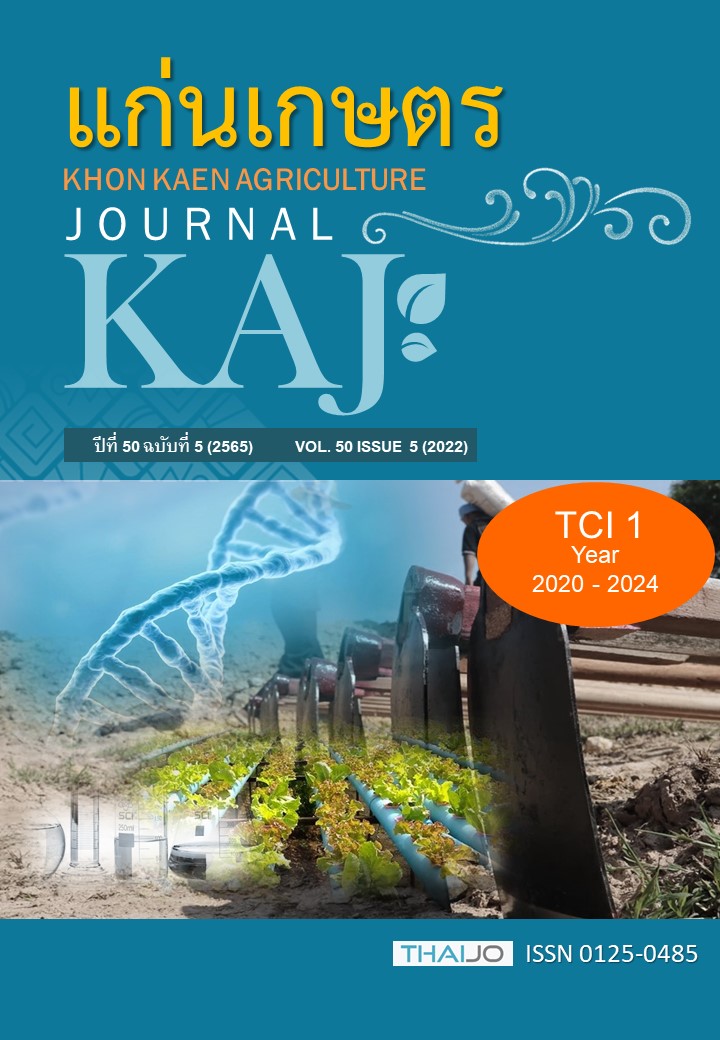การประเมินพริกพันธุ์ปรับปรุง (Capsicum annuum L.) ที่ได้รับยีนต้านทานโรคแอนแทรกโนสจากพริกพันธุ์ PBC80 และ PBC932 ต้านทานต่อเชื้อ Colletotrichum acutatum
Main Article Content
บทคัดย่อ
โรคแอนแทรกโนสส่งผลให้พริกเกิดอาการผลเน่าเสียทั้งก่อนและหลังการเก็บเกี่ยว ดังนั้นงานวิจัยนี้จึงมีวัตถุประสงค์เพื่อประเมินพันธุ์พริกต้านทานต่อโรคแอนแทรกโนสในพริกพันธุ์ที่ผ่านการปรับปรุงพันธุ์ (progressive line) ที่ได้รับยีนจากแหล่งเชื้อพันธุกรรมต้านทาน 2 แหล่งคือ PBC80 และ PBC932 เปรียบเทียบกับพันธุ์การค้า และพันธุ์อ่อนแอ จำนวน 21 สายพันธุ์ ในระยะผลเขียว ผลสุกห่าม และผลแดง ด้วยเชื้อแอนแทรกโนส C. acutatum (Ca_KK) โดยวิธีการปลูกเชื้อแบบพ่นสปอร์เชื้อแขวนลอย (spore suspension) ลงบนต้นพริกที่อายุ 75 วันหลังย้ายปลูก วางแผนการทดลองแบบ randomized complete block design (RCBD) จำนวน 3 ซ้ำ ๆ ละ 3 ต้น ประเมินการเกิดโรคที่ 14 วันหลังปลูกเชื้อ และนำค่าคะแนนการเกิดโรคมาคำนวณค่าเปอร์เซ็นต์ดัชนีการเกิดโรค (DI) สำหรับการตรวจสอบยีนต้านทานโรคโดยใช้เครื่องหมายโมเลกุลชนิด SSR-HpmsE032 และ SCAR-Indel ผลการทดลองพบว่าพริก 21 สายพันธุ์มีการตอบสนองต่อเชื้อ Ca_KK ในระยะผลเขียว ผลสุกห่าม และผลแดง แตกต่างกันในทางสถิติ โดยพบจำนวนพันธุ์ต้านทานในระยะผลเขียว จำนวน 5 สายพันธุ์ คือ ANT4 ANT6 ANT9 ANT17 และ ANT18 และระยะผลแดงจำนวน 2 สายพันธุ์ คือ ANT4 และ ANT12 ในขณะที่ระยะผลสุกห่ามไม่พบพันธุ์ที่ต้านทาน และเมื่อศึกษาสหสัมพันธ์ของการเกิดโรคแอนแทรกโนสในระยะสุกแก่ของผลพริก 3 ระยะคือ ระยะผลเขียว ผลห่าม และระยะผลแดงพบว่ามีความสัมพันธ์กับในทางบวกแต่มีค่าต่ำอยู่ระหว่าง 0.41-0.56 การตรวจสอบยีนต้านทานพบพริกจำนวน 2 สายพันธุ์คือ ANT4 ANT17 ที่แสดงยีนต้านทานโดยใช้เครื่องหมายโมเลกุลชนิด SSR-HpmsE032 และ พริกจำนวน 3 สายพันธุ์คือ ANT1 ANT9 และ ANT10 ที่แสดงยีนต้านทานด้วย เครื่องหมายโมเลกุลชนิด SCAR-Indel และเครื่องหมายโมเลกุลมีประสิทธิภาพในการคัดเลือกอยู่ระหว่างร้อยละ 71.42-90.47
Article Details

อนุญาตภายใต้เงื่อนไข Creative Commons Attribution-NonCommercial-NoDerivatives 4.0 International License.
เอกสารอ้างอิง
อรรัตน์ มงคลพร. 2548. เครื่องหมายโมเลกุลเพื่อการปรับปรุงพันธุ์พืช. จรัญสนิทวงศ์การพิมพ์, กรุงเทพฯ.
AVRDC. 1999. AVRDC Progress Report 1998. AVRDC-the World Vegetable Center. Shanhua. Taiwan.
Bailey, J. A., and M. J. Jeger. 1992. Colletotrichum: Biology, Pathology and Control. Walling Ford. Commonwealth Mycological Institute.
Damm, U., P. F. Cannon, J. H. C. Woudenberg, P. R. Johnston, B. S. Weir, Y. P. Tan, R. G. Shivas, and P. W. Crous. 2012. The Colletotrichum boninense species complex. Studies in Mycology. 73: 1–36.
Harp, T. L., K. Pernezny, M. L. Lewis-Ivey, S. A. Miller, P. J. Kuhn, and L. Datnoff. 2008. The etiology of recent pepper anthracnose outbreaks in Florida. International Association for the Plant Protection Sciences. 27: 1380–1384.
Kim, S. H., J. B. Yoon, and H. G. Park. 2008. Inheritance of anthracnose resistance in a new genetic resource, Capsicum baccatum PI 594137. Journal of Crop Science and Biotechnology. 11: 13–16.
Kim, S. H., J. B. Yoon, J. W. Do, and H. G. Park. 2008. A major recessive gene associated with anthracnose resistance to Colletotrichum capsici in chili pepper (Capsicum annuum L.). Breeding Science. 58: 137-141.
Ko, M. K., W. B. Jeon, K. S. Kim, H. H. Lee, H. H. Seo, Y. S. Kim, and B. J. Oh. 2005. A Colletotrichum gloeosporioides induced esterase gene of non climacteric pepper (Capsicum annuum) fruit during ripening plays a role in resistance against fungal infection. Plant Molecular Biology. 58:529–541.
Lee, J., J. H. Hong, J. W. Do, and J. B. Yoon. 2010. Identification of QTLs for resistance to anthracnose to two Colletotrichum species in pepper. Journal of Crop Science and Biotechnology 13 (4): 227-233.
Lee, J., J. W. Do, and J. B. Yoon. 2011. Development of STS markers linked to the major QTLs for resistance to the pepper anthracnose caused by Colletotrichum acutatum and C. capsici. Horticulture Environment Biotechnology. 52: 596–601.
Lewis-Ivey, M. L., C. Nava-Diaz, and S. Miller. 2004. Identification and management of Colletotrichum acutatum on immature bell peppers. Plant Disease. 88: 1198–1204.
Mahasuk, P., J. Chinthaisong, and O. Mongkolporn. 2013. Differential resistances to anthracnose in Capsicum baccatum as responding to two Colletotrichum pathotypes and inoculation methods. Breeding Science. 63 (3): 333–338.
Mahasuk, P., P. W. J. Taylor, and O. Mongkolporn. 2009. Identification of two new genes Conferring resistance to Colletotrichum acutatum in Capsicum baccatum. Phytopathology. 99: 1100–1104.
Montri, P. P., P. W. J. Taylor, and O. Mongkolporn. 2009. Pathotypes of Colletotrichum capsici the causal agent of chili anthracnose in Thailand. Plant Disease. 93(1): 17–20.
Park, H. G., B. S. Kim, and W. S. Kim. 1990. Inheritance of resistance to anthracnose (Colletotrichum spp.) in pepper (Capsicum annuum L.). II. Genetics analysis of resistance to Colletotrichum dematium. Korean Journal of Horticultural Science and Technology. 31: 207-212.
Park, H. G. 2007. Problems of anthracnose in pepper and prospects for its management, pp.19. In The First International Symposium on Chili Anthracnose, Convention Center, Seoul National University, Korea.
Suwor, P., P. Thummabenjapone, J. Sanichon, S. Kumar, and S. Techawongstien. 2015. Phenotypic and genotypic responses of chili (Capsicum annuum L.) progressive lines with different resistant genes against anthracnose pathogen (Colletotrichum spp.). European Journal of Plant Pathology. 143: 725-736.
Suwor, P., J. Sanitchona, P. Thummabenjapone, S. Kumar, and S. Techawongstien. 2017. Inheritance analysis of
anthracnose resistance and marker-assisted selection in introgression populations of chili (Capsicum annuum L.). Scientia Horticulturae. 220: 20-26.
Than, P. P., R. Jeewon, K. D. Hyde, S. Pongsupasamit, O. Mongkolporn, and P. W. J. Taylor. 2008. Characterization and pathogenicity of Colletotrichum species associated with anthracnose on chilli (Capsicum spp.) in Thailand. Journal of Plant Pathology. 57: 562–572.
Voorrips, R.E., R. Finkers, L. Sanjaya, and R. Groenworld. 2004. QTL mapping of anthracnose (Colletotrichum spp.) resistance in a cross between Capsicum annuum and C. chinense. Theoretical and Applied Genetics 109: 1275-1282.


